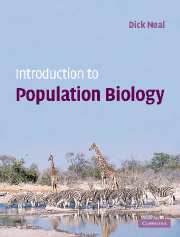Book contents
- Frontmatter
- Contents
- Preface
- Acknowledgements
- PART I Evolution by natural selection
- PART II Simple population growth models and their simulation
- PART III Population genetics and evolution
- PART IV Demography
- Chapter 14 Life tables and age-specific death rates
- Chapter 15 Age-specific reproduction and population growth rates
- Chapter 16 Evolution of life histories
- PART V Interactions between species, and the behaviour of individuals
- Glossary
- Solutions to problems
- References
- Index
Chapter 16 - Evolution of life histories
- Frontmatter
- Contents
- Preface
- Acknowledgements
- PART I Evolution by natural selection
- PART II Simple population growth models and their simulation
- PART III Population genetics and evolution
- PART IV Demography
- Chapter 14 Life tables and age-specific death rates
- Chapter 15 Age-specific reproduction and population growth rates
- Chapter 16 Evolution of life histories
- PART V Interactions between species, and the behaviour of individuals
- Glossary
- Solutions to problems
- References
- Index
Summary
If different phenotypes have different age-specific birth and death rates, their growth rates, and hence their fitness (see Chapter 10) will vary. Thus, natural selection shapes both the survivorship (lx) and fecundity (mx) curves, and we will look at this particular aspect of evolution in this chapter. However, the life-history characteristics of organisms also include such traits as body size, size of the offspring at birth, the degree of parental care provided to the young, and so on, and consequently our review will also consider some of these life-history traits.
A simplistic view of natural selection would suggest that all organisms should adopt an ideal life history in which they live as long as possible, start to reproduce at an early age, reproduce frequently, and produce a vast number of offspring which have a high rate of survival. However, even a cursory look at the life-history traits of different organisms shows that this is not the case in nature. Consider the following three examples of large, long-lived organisms.
Adult blue whales (Balaenoptera musculus) are about 27 metres long, weigh about 150 tonnes, and may live for about 80 years. After a gestation period of about one year, females normally produce a single, well-developed offspring that weighs as much as an adult elephant. The young calves suckle for about a year, and are provided with considerable parental care and protection during their early life. Their survival is quite high.
- Type
- Chapter
- Information
- Introduction to Population Biology , pp. 245 - 262Publisher: Cambridge University PressPrint publication year: 2003



